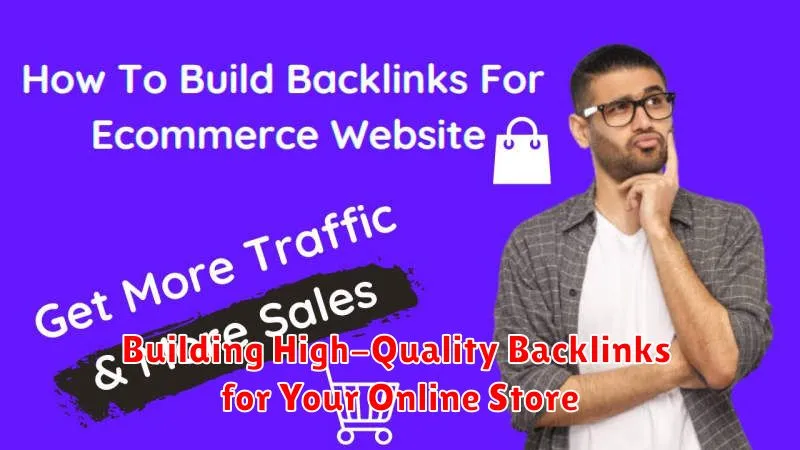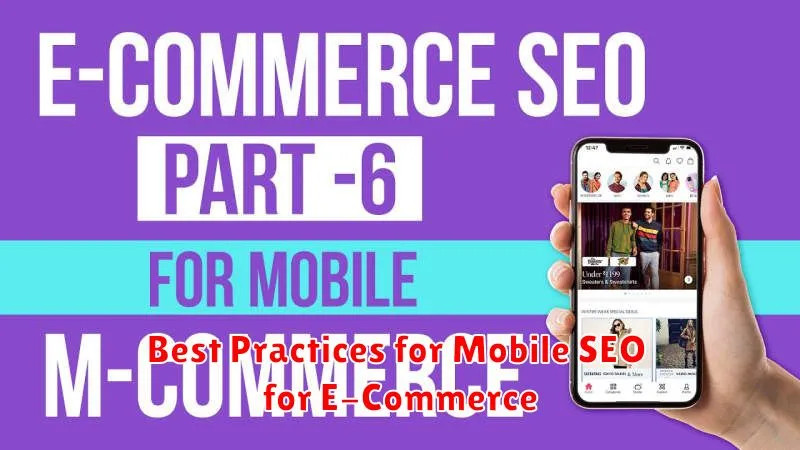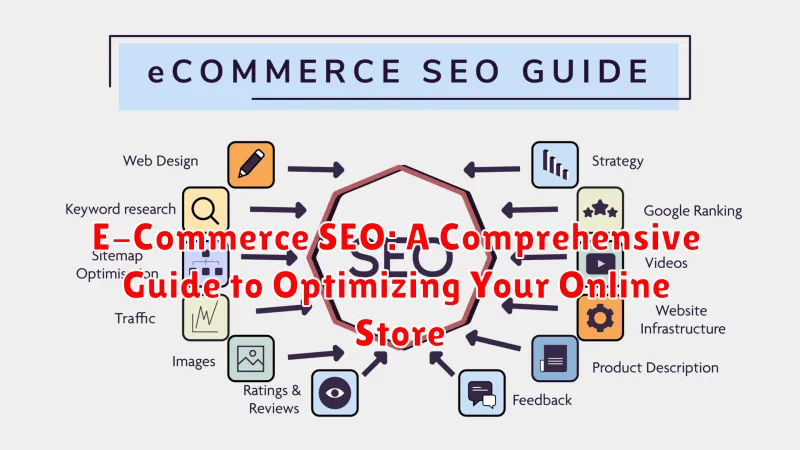In today’s competitive digital landscape, e-commerce SEO is more crucial than ever for online businesses. Optimizing your online store for search engines like Google is essential for driving organic traffic, increasing brand visibility, and ultimately boosting sales. This comprehensive guide will delve into the intricacies of e-commerce SEO, providing actionable strategies to improve your search engine rankings and attract a wider audience to your products.
From keyword research and on-page optimization to technical SEO and link building, we’ll cover every aspect of optimizing your e-commerce website. Whether you’re a seasoned online retailer or just starting out, this guide will equip you with the knowledge and tools needed to succeed in the world of e-commerce SEO, driving sustainable growth and establishing a strong online presence. Master the art of e-commerce SEO and watch your online store flourish.
What is E-Commerce SEO and Why is it Important?
E-commerce SEO is the practice of optimizing your online store to rank higher in search engine results pages (SERPs). It involves a variety of techniques aimed at improving your visibility to potential customers searching for products like yours. By optimizing your site, you increase organic (non-paid) traffic, which is crucial for sustainable growth.
Why is it so important? Simply put, higher rankings mean more visibility. When your store appears on the first page of search results for relevant keywords, you’re significantly more likely to attract clicks and potential customers. This translates directly into increased sales and revenue. Organic search traffic is also generally more targeted than paid traffic, meaning visitors arriving via search engines are actively looking for products you offer.
Ignoring E-commerce SEO can be detrimental. If your competitors are optimizing their stores and you’re not, they’ll capture the majority of organic traffic, leaving you struggling to gain visibility and attract customers. In today’s competitive online landscape, E-commerce SEO is no longer optional; it’s a necessity for success.
Keyword Research and Targeting for E-Commerce
Keyword research is the foundation of successful e-commerce SEO. It involves identifying the search terms your potential customers use when looking for products like yours. Effective keyword targeting drives organic traffic and increases visibility.
Start by brainstorming relevant keywords related to your products. Consider product names, categories, features, and benefits. Use keyword research tools to expand your list and analyze search volume and competition.
Focus on long-tail keywords. These are longer, more specific phrases that target niche searches. For example, instead of “shoes,” target “men’s leather running shoes size 10.” Long-tail keywords often have less competition and higher conversion rates.
Analyze competitor websites to see which keywords they are targeting. This can provide valuable insights and identify opportunities.
On-Page Optimization for Product Pages
On-page optimization for product pages is crucial for e-commerce SEO. It focuses on optimizing individual product pages to rank higher in search engine results and attract more qualified traffic. This involves strategically incorporating relevant keywords and creating compelling content directly on the product page itself. By optimizing various elements within each product page, you can enhance its visibility and drive conversions.
Key elements to consider include:
- Product Titles: Use descriptive and accurate product titles that incorporate relevant keywords. Keep them concise and compelling.
- Product Descriptions: Write unique and detailed product descriptions that highlight key features and benefits. Naturally incorporate relevant keywords.
- Meta Descriptions: Craft compelling meta descriptions that accurately reflect the product page content and entice users to click.
- Image Optimization: Use descriptive alt text for all product images, incorporating relevant keywords where appropriate. Optimize image file sizes for faster loading times.
- Structured Data: Implement structured data markup to provide search engines with more information about your products, like price, availability, and reviews.
By carefully optimizing these on-page elements, you can improve the visibility of your product pages and attract more potential customers.
Technical SEO for E-Commerce Websites
Technical SEO ensures search engines can easily crawl and index your e-commerce website. A technically sound website provides a better user experience, which indirectly boosts SEO. This involves various aspects of your site’s infrastructure.
Site Speed is crucial. A slow website leads to higher bounce rates and lower rankings. Optimize images, leverage browser caching, and choose a reliable hosting provider.
Mobile-Friendliness is essential as many users shop on mobile devices. Implement a responsive design that adapts to different screen sizes.
Crawlability and Indexability ensure search engines can discover and understand your content. Create a clear sitemap and robots.txt file to guide search engine bots. Avoid duplicate content and use canonical tags when necessary.
Structured Data helps search engines understand your product information. Implement schema markup to provide context to your product pages, including price, availability, and reviews. This can lead to rich snippets in search results.
HTTPS is vital for security and SEO. Ensure your site uses a secure HTTPS connection.
Building High-Quality Backlinks for Your Online Store

Backlinks remain a critical ranking factor for e-commerce websites. High-quality backlinks from reputable sources signal to search engines that your store is trustworthy and authoritative, boosting your visibility in search results.
Focus on earning backlinks through genuine outreach and content creation. Guest posting on relevant industry blogs can be an effective strategy. Create informative and engaging content that other websites will naturally want to link to.
Avoid any black-hat or manipulative link-building tactics. These practices can harm your website’s ranking and even lead to penalties from search engines. Prioritize building a natural backlink profile through ethical and sustainable methods.
Strategies for Earning Backlinks
- Guest blogging: Contribute valuable content to authoritative blogs in your niche.
- Broken link building: Identify broken links on relevant websites and offer your content as a replacement.
- Infographic outreach: Create visually appealing infographics and promote them to relevant websites.
- Product reviews: Encourage satisfied customers to leave reviews on product review websites.
Optimizing Site Structure and Navigation for E-Commerce
A well-organized site structure is crucial for both user experience and SEO. It allows search engines to easily crawl and index your product pages, leading to improved visibility in search results. A clear and intuitive navigation system also helps customers quickly find the products they’re looking for.
Prioritize a logical hierarchy. Organize your products into relevant categories and subcategories. This hierarchical structure should be reflected in your URL structure, making it easier for search engines to understand the relationship between your pages. For example: example.com/category/subcategory/product.
Internal linking is also essential. Connect related product pages within your category structure to distribute link equity and help users discover relevant items. A well-placed breadcrumb navigation can further enhance user experience and site navigation.
Ensure your sitemap is up-to-date and submitted to Google Search Console. This helps search engines understand your website’s structure and index new pages efficiently.
Creating a Content Strategy to Drive Organic Traffic
A robust content strategy is crucial for attracting organic traffic to your e-commerce store. Targeted content caters to your audience’s needs and search intent, driving engagement and conversions. Begin by understanding your target audience – their demographics, interests, and online behavior. This informs keyword research, enabling you to create content around terms they actively search for.
Keyword research forms the foundation of content creation. Tools like Google Keyword Planner help identify relevant keywords with high search volume. Incorporate these keywords naturally within your content, avoiding keyword stuffing. Diversify content formats, employing blog posts, product descriptions, buyer guides, and FAQs to cater to various user preferences. High-quality, informative content not only attracts organic traffic but also establishes your brand as an authority in your niche.
A content calendar helps organize and schedule content, ensuring consistent publishing. Track content performance using analytics tools to identify what resonates with your audience and adjust your strategy accordingly. Remember, content creation is an ongoing process requiring continuous refinement and optimization.
Measuring and Analyzing SEO Performance
Measuring and analyzing your e-commerce SEO performance is crucial for understanding the effectiveness of your strategies and identifying areas for improvement. Regular monitoring allows you to track progress, adapt to algorithm changes, and ultimately, drive more organic traffic and conversions.
Key metrics to track include:
- Organic traffic: Monitor the number of visitors coming to your site from organic search results.
- Keyword rankings: Track your position in search engine results pages (SERPs) for relevant keywords.
- Conversion rate: Measure the percentage of organic traffic that completes a desired action, such as a purchase.
- Bounce rate: Analyze the percentage of visitors who leave your site after viewing only one page.
- Time on site: Track how long visitors spend on your site, indicating engagement levels.
Utilize tools like Google Analytics and Google Search Console to gather data and gain valuable insights into your SEO performance. Regularly analyze this data to identify trends, understand user behavior, and refine your SEO strategy for optimal results.
Best Practices for Mobile SEO for E-Commerce

Mobile optimization is crucial for e-commerce success. More and more users shop on their smartphones, making a mobile-friendly site essential for increased visibility and conversions. Follow these best practices to ensure your online store excels on mobile devices.
Page Speed is Paramount. A fast-loading site is critical for a positive mobile user experience. Optimize images, leverage browser caching, and minimize redirects to improve load times.
Responsive Design. Implement a responsive design that adapts seamlessly to different screen sizes. This ensures a consistent user experience across all devices, avoiding the need for separate mobile sites.
Mobile-First Indexing. Google predominantly uses the mobile version of your site for indexing and ranking. Ensure your mobile site has all the same content and features as your desktop version. Prioritize mobile usability during development.
Simplified Navigation. Streamline your site navigation for mobile users. Use a clear and concise menu structure, and make sure buttons and links are easily tappable with fingers.

